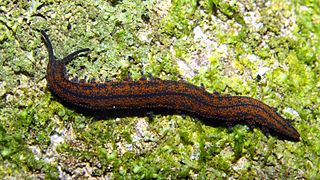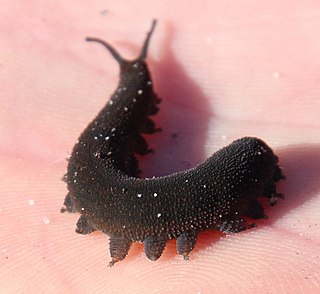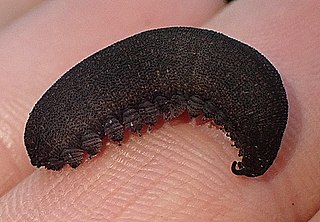Related Research Articles

Peripatoides indigo is a velvet worm of the family Peripatopsidae. The Māori name for the velvet worm is ngaokeoke, from the Māori word 'ngaoki', to crawl.

Peripatoides is a genus of velvet worms in the family Peripatopsidae, whose species are found in New Zealand. Like all velvet worms, these animals are nocturnal hunters that spit glue to trap their prey. Species of Peripatoides have 14, 15 or 16 pairs of legs. Female Peripatoides produce eggs that are fertilized internally and babies develop inside their mother until large enough to be born, in batches of 4-6, as colourless miniatures of the parents. These live-bearing Peripatoides have dermal-haemocoelic sperm transfer - which means sperm dissolve holes in the skin of the female to enter the body (haemolymph) anywhere on the body wall of the female.
Peripatoides suteri is a species of velvet worm in the Peripatopsidae family. This species is ovoviviparous has 16 pairs of legs. It is endemic to New Zealand.
Epiperipatus imthurni is a species of velvet worm in the family Peripatidae. The type locality is in Guyana. No males have been recorded from this species. Females have 28 to 32 pairs of legs, usually 30 or 31. Females from Trinidad were shown to reproduce via parthenogenesis; the only velvet worm known to do so.
Epiperipatus acacioi is a species of velvet worm in the Peripatidae family. Males of this species have 24 to 26 pairs of legs; females have 26 to 29. The type locality is in Minas Gerais, Brazil.
Epiperipatus broadwayi is a species of velvet worm in the Peripatidae family. This species has 29 to 34 pairs of legs. The type locality is in Tobago.
Epiperipatus cratensis is a species of velvet worm in the family Peripatidae. Females of this species have 33 or 34 pairs of legs; males have 30 to 33 pairs. The type locality is in Ceará, Brazil.
Epiperipatus diadenoproctus is a species of velvet worm in the Peripatidae family. Males of this species have 26 to 28 pairs of legs; females have 29 or 30. The type locality is in Minas Gerais, Brazil.
Epiperipatus paurognostus is a species of velvet worm in the Peripatidae family. Males of this species have 26 or 27 pairs of legs; females have 27 to 29. The type locality is in Minas Gerais, Brazil.

Epiperipatus edwardsii is a species of velvet worm in the Peripatidae family. Females of this species have 29 to 34 pairs of legs; males have 28 to 30. The type locality is in French Guiana.
Epiperipatus machadoi is a species of velvet worm in the Peripatidae family. Males of this species have 27 to 29 pairs of legs; females have 28 to 31. The type locality is in Minas Gerais, Brazil.
Macroperipatus torquatus is a species of velvet worm in the Peripatidae family. This species has a brown or red back with a bright yellow collar, a black head with black antennae, a white underside with a red tint, and 37 to 42 pairs of legs. This species is found in Trinidad.

Oroperipatus eisenii is a species of velvet worm in the family Peripatidae. Females of this species have 27 to 29 pairs of legs, usually 28; males have 23 to 26. The type locality is found in central Mexico.

Ooperipatellus nanus is a species of velvet worm in the family Peripatopsidae. This species is endemic to New Zealand and is found in the South Island.
Peripatopsis balfouri is a species of velvet worm in the Peripatopsidae family. This species has 18 pairs of clawed legs. The type locality is in South Africa.

Peripatopsis capensis is a species of velvet worm in the Peripatopsidae family. This species has 18 pairs of legs: 17 pregenital leg pairs with claws plus one last pair that is strongly reduced and without claws or spinous pads. The native range of this species is limited to the Cape Peninsula of South Africa.

Peripatopsis moseleyi is a species of velvet worm in the Peripatopsidae family. Females of this species have 19 to 23 pairs of legs with claws ; males have 20 to 24 pairs of legs with claws. The type locality is in South Africa.
Peripatopsis sedgwicki is a species of velvet worm in the Peripatopsidae family. This species can have either 20 or 21 pairs of legs, but descriptions usually report 20 pairs of clawed legs. The type locality is in South Africa.

Peripatopsis alba, the white cave velvet worm, is a species of velvet worm in the family Peripatopsidae. This species has 18 pairs of legs, with the last pair reduced, and no eyes.

The Knysna velvet worm is a species of velvet worm in the Peripatopsidae family. This species has 17 pairs of legs with claws, with the last pair of legs reduced. Peripatopsis clavigera is found in subtropical or tropical moist montane forests of South Africa.
References
- ↑ Oliveira, I.; Hering, L. & Mayer, G. "Updated Onychophora checklist". Onychophora Website. Retrieved 24 November 2016.
- ↑ Trewick, S. A. (2000). "Mitochondrial DNA sequences support allozyme evidence for cryptic radiation of New Zealand Peripatoides (Onychophora)". Molecular Ecology. 9 (3): 269–281. doi:10.1046/j.1365-294x.2000.00873.x. ISSN 0962-1083.
- 1 2 Trewick, Steven A. (March 1998). "Sympatric cryptic species in New Zealand Onychophora". Biological Journal of the Linnean Society. 63 (3): 307–329. doi: 10.1111/j.1095-8312.1998.tb01520.x .
- ↑ Oliveira, I. S.; Read, V. M. S. J.; Mayer, G. (2012). "A world checklist of Onychophora (velvet worms), with notes on nomenclature and status of names". ZooKeys (211): 1–70. doi: 10.3897/zookeys.211.3463 . PMC 3426840 . PMID 22930648.
- ↑ "Peripatoides kawekaensis Trewick, 1998". collections.tepapa.govt.nz. Retrieved 2018-09-15.
- ↑ Trewick, Steve; Hitchmough, Rod; Rolfe, Jeremy; Stringer, Ian (2018). "Conservation status of New Zealand Onychophora ('peripatus' or velvet worm), 2018" (PDF). New Zealand Threat Classification Series. 26. Department of Conservation: 1–3. ISBN 9781988514703.